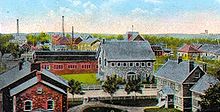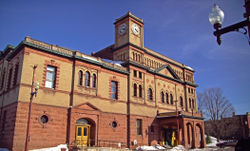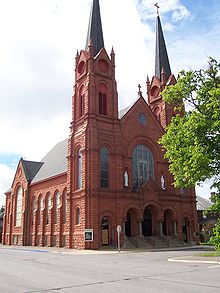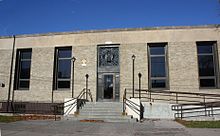- Calumet, Michigan
-
Calumet, Michigan — Village — Location of Calumet, Michigan Coordinates: 47°14′50″N 88°27′16″W / 47.24722°N 88.45444°W Country United States State Michigan County Houghton Area – Total 0.2 sq mi (0.5 km2) – Land 0.2 sq mi (0.5 km2) – Water 0.0 sq mi (0.0 km2) Elevation 1,214 ft (370 m) Population (2000) – Total 879 – Density 4,524.2/sq mi (1,746.8/km2) Time zone Eastern (EST) (UTC-5) – Summer (DST) EDT (UTC-4) ZIP codes 49913, 49942 Area code(s) 906 FIPS code 26-12580[1] GNIS feature ID 0622468[2] Calumet (
 /kæl.juːˈmɛt/ kal-yew-met) is a village in Calumet Township, Houghton County, in the U.S. state of Michigan's Upper Peninsula, that was once at the center of the mining industry of the Upper Peninsula. Also known as Red Jacket, the village includes the Calumet Downtown Historic District, listed on the National Register of Historic Places (NRHP). The village may itself be included within the Calumet Historic District, a larger area which is NRHP-listed and which is a National Historic Landmark District. It is bordered on the north by Calumet Township, on the south by the unincorporated town of New Town and Blue Jacket[3][4] , on the east by Blue Jacket and Calumet Township, and on the west by Yellow Jacket and Calumet Township. The population was 879 at the 2000 census. Calumet's nickname is Copper Town U.S.A.
/kæl.juːˈmɛt/ kal-yew-met) is a village in Calumet Township, Houghton County, in the U.S. state of Michigan's Upper Peninsula, that was once at the center of the mining industry of the Upper Peninsula. Also known as Red Jacket, the village includes the Calumet Downtown Historic District, listed on the National Register of Historic Places (NRHP). The village may itself be included within the Calumet Historic District, a larger area which is NRHP-listed and which is a National Historic Landmark District. It is bordered on the north by Calumet Township, on the south by the unincorporated town of New Town and Blue Jacket[3][4] , on the east by Blue Jacket and Calumet Township, and on the west by Yellow Jacket and Calumet Township. The population was 879 at the 2000 census. Calumet's nickname is Copper Town U.S.A.Contents
History
What is now Calumet was settled in 1864, originally under the name of "Red Jacket",[5] named for a Native American Chief of the Seneca tribe. Until 1895 the name "Calumet" was used by the nearby town of Laurium, Michigan; present day Calumet was not legally named so until 1929.
Red Jacket grew due to the copper mines in the area. It was incorporated as a town in 1867. The copper mines were particularly rich; the Red Jacket-based Calumet and Hecla Mining Company produced more than half of the USA's copper from 1871 through 1880.[6] In addition to copper mining and smelting, the region also supported the dairy industry and truck farming.
By 1900, Red Jacket had a population of 4,668, and Calumet Township, which contained Red Jacket and nearby mining towns, had a population of 25,991. However, in 1913, Red Jacket suffered from the Copper Country Strike of 1913-1914, and the population began to decline. In the same year, the town was the site of the Italian Hall Disaster. Striking miners and their families were gathered on Christmas Eve for a party in Italian Hall, when the cry of "fire" precipitated a stampede that crushed or suffocated seventy-three victims, the majority of them children. The identity of the person(s) who started the stampede has never been determined. Folk singer Woody Guthrie's song, "1913 Massacre", is based on this event.
Loss of wartime demand caused the copper price to drop following World War I. With the decreased demand for copper, thousands left Red Jacket in the 1920s, many moving to Detroit, Michigan where the automobile industry was booming.
In 1929, Red Jacket and surrounding company towns including "Laurium, Hecla, and South Hecla" were reincorporated as the town of "Calumet".[7] To be even more confusing, the area once officially known as Calumet was then re-named to Laurium.
During the Great Depression, almost all mines were shut down. As a result, many miners and their families left to find work. In 1950, the population of Calumet was 1,256 people. Small-time mining continued in the area, particularly during World War II until it was shut down completely by a labor strike in 1968.
The Calumet Historic District is another area of interest, listed like the Calumet Downtown Historic District on the National Register of Historic Places.
Geography
According to the United States Census Bureau, the village has a total area of 0.2 square miles (0.52 km2), all land.
Calumet is at an elevation of 1,209 feet (369 m) above sea level.
Parts of the Keweenaw National Historical Park are located inside the village limits.
The village of Calumet now sits on over 2,000 miles (3,200 km) of underground mine shafts, drifts and stopes, empty for many decades.
People and Culture
One of the biggest parts of the culture of not only Calumet, but the entire Copper Country is the pasty. This was a main part of copper miners' diets. A pasty is a mixture of meat, potatoes, rutabaga, carrots and onions wrapped in a crust made of flour and lard. Traditionally Cornish, they have even sparked local events such as the Pasty Fest, where there are eating contests (with consumption of pasties, of course), games, events, and even a tug of war event where the losers take a dive into an inflatable pool filled with ketchup.
Theatre
The Calumet Theatre is a theater and opera house which was constructed in 1900. In 1898, the copper mining industry was booming, and the town had an enormous surplus in its treasury. The town council decided to spend some of the surplus on a theater. The theater hosted a large number of famous actors, musicians, and opera singers.[8] With the close of the mines, the theater became a movie theater and fell into general disrepair for many years. In 1975, the town began a large project to repair and restore the theater, which is now used for many local and touring productions. The theatre is a National Historic Landmark.
Churches
St. Paul the Apostle Church
St. Paul the Apostle Church, formerly known as St. Joseph’s Catholic Church, was formed in 1889 by Slovenian immigrants who came to the Calumet area to work in the booming copper mines. The first church that they built burnt down in 1902, but the church was rebuilt by 1908.[9] The church “rises authoritatively over the village like a cathedral of medieval Europe.” [10] When the church was completed, the cost of construction was an amazing $100,000. It is constructed of local Jacobsville sandstone, and features beautiful stained glass windows, a custom built 19’ by 18’ pipe organ, and a beautifully painted interior. The interior of the church remains virtually unchanged architecturally.[11] In 1966, four of the five Catholic churches in the Calumet area were forced to merge because of the low number of parishioners and economic constraints. This included St. Anne’s (the French church), St. John’s (the Croatian church), St. Mary’s (the Italian church), and St. Joseph’s. The combined parish is housed in the old St. Joseph’s building, and has changed its name to St. Paul the Apostle Church.[12] Today, they have a large and active congregation, which pays for the upkeep of the church.[13]
Notable natives & entertainment
- James Tolkan, an American actor often cast as a strict, overbearing, bald-headed authority figure.
- Percy Ross, an American self-made multi-millionaire.
- George Gipp, a college football player who played for the University of Notre Dame.
- Paul J. Smith, an American music composer.
- Children of the Night, a 1991 horror film directed by Tony Randel, was shot here.
- Tyler Lumsden wardrobe artist for the motion picture The Rocky Horror Picture Show
- Bill Ivey former chairman of the Country Music Hall of Fame and former chairman of the National Endowment of the Arts
Demographics
Historical populations Census Pop. %± 1880 2,140 — 1890 3,073 43.6% 1900 4,668 51.9% 1910 4,211 −9.8% 1920 2,390 −43.2% 1930 1,557 −34.9% 1940 1,400 −10.1% 1950 1,256 −10.3% 1960 1,139 −9.3% 1970 1,007 −11.6% 2000 879 — 2010 798 −9.2% As of the census[1] of 2000, there were 879 people, 387 households, and 136 families residing in the village. The population density was 4,524.2 per square mile (1,786.2/km²). There were 491 housing units at an average density of 2,527.1 per square mile (997.8/km²). The racial makeup of the village was 98.98% White, 0.23% from other races, and 0.80% from two or more races. 0.80% of the population were Hispanic or Latino of any race. 35.7% were of Finnish, 10.3% German, 9.3% Irish, 7.1% United States or American, 7.0% French and 6.5% Italian ancestry according to Census 2000. 95.7% spoke English, 3.0% Spanish and 1.2% Finnish as their first language.
There were 387 households out of which 20.2% had children under the age of 18 living with them, 19.9% were married couples living together, 12.4% had a female householder with no husband present, and 64.6% were non-families. 58.1% of all households were made up of individuals and 25.8% had someone living alone who was 65 years of age or older. The average household size was 1.85 and the average family size was 3.12.
In the village the population was spread out with 20.0% under the age of 18, 24.8% from 18 to 24, 21.8% from 25 to 44, 15.8% from 45 to 64, and 17.5% who were 65 years of age or older. The median age was 29 years. For every 100 females there were 95.8 males. For every 100 females age 18 and over, there were 91.6 males.
The median income for a household in the village was $17,404, and the median income for a family was $22,750. Males had a median income of $21,667 versus $18,125 for females. The per capita income for the village was $12,111. About 29.0% of families and 35.0% of the population were below the poverty line, including 50.5% of those under age 18 and 18.9% of those age 65 or over.
Libraries, Museums, and Galleries
- Calumet Public Library
- Copper Country Associated Artists
- Spare Room Gallery
- The Vertin Gallery is another gallery with works by local artists, including open, working studio space on the second floor.
Schools
- Calumet High School
- Horizons Alternative High School
- Washington Middle School
- CLK Elementary School
Notes and references
- ^ a b "American FactFinder". United States Census Bureau. http://factfinder.census.gov. Retrieved 2008-01-31.
- ^ "US Board on Geographic Names". United States Geological Survey. 2007-10-25. http://geonames.usgs.gov. Retrieved 2008-01-31.
- ^ Richards Family Obituaries Houghton Co., Michigan
- ^ Eckert, Katerine Bishop (Reprint Edition 1995). Buildings of Michigan (Society of Architectural Historians). Oxford University Press, USA. pp. 461. ISBN 0195093798.
- ^ "MTU Digital Archive". http://digarch.lib.mtu.edu/showbib.aspx?bib_id=603837#.
- ^ Horace J. Stevens (1902) The Copper Handbook, v.2, Houghton, Mich.: Horace J. Stevens, p.1457,1466.
- ^ "InfoMI page on Calumet". http://www.infomi.com/city/calumet/.
- ^ "History of the Calumet Theatre". http://www.calumettheatre.com/history.htm.
- ^ St. Joseph’s Church of Calumet, Michigan. (1965) Diamond Jubilee St. Joseph’s Church Calumet, Michigan. “History of St. Joseph’s Parish.” pp. 16-18.
- ^ Eckert, Kathryn (1993). Buildings of Michigan. New York: Oxford University Press Inc. p. 476.
- ^ St. Paul the Apostle Church pamphlet Taken from the information center in the back of St. Paul the Apostle church.
- ^ "St. Paul the Apostle, Calumet". http://www.dioceseofmarquette.org/parishhistory.asp?parishID=143.
- ^ Yarbrough, Edward (1996). Church Architecture in the Calumet – Laurium Settlement Area, MI – A study of ethno-religious forms, regional building material, social history, and preservation issues. (Thesis). University of Oregon. p. 49.
External links
Municipalities and communities of Houghton County, Michigan Cities Villages Calumet | Copper City | Lake Linden | Laurium | South Range
Charter
townshipsGeneral law
townshipsUnincorporated
communitiesAlston | Atlantic Mine | Baltic | Chassell | Dakota Heights | Dodgeville | Dollar Bay | Donken | Dreamland | Franklin Mine | Freda | Hubbell | Hurontown | Jacobsville | Kenton | Klingville | Mason | Nisula | Painesdale | Portage Entry | Ripley | Seeberville | Senter | Sidnaw | Swedetown | Tapiola | Toivola | Winona
Coordinates: 47°14′48″N 88°27′14″W / 47.24667°N 88.45389°W
Categories:- Company towns in Michigan
- Populated places in Houghton County, Michigan
- Villages in Michigan
- Houghton micropolitan area
Wikimedia Foundation. 2010.








